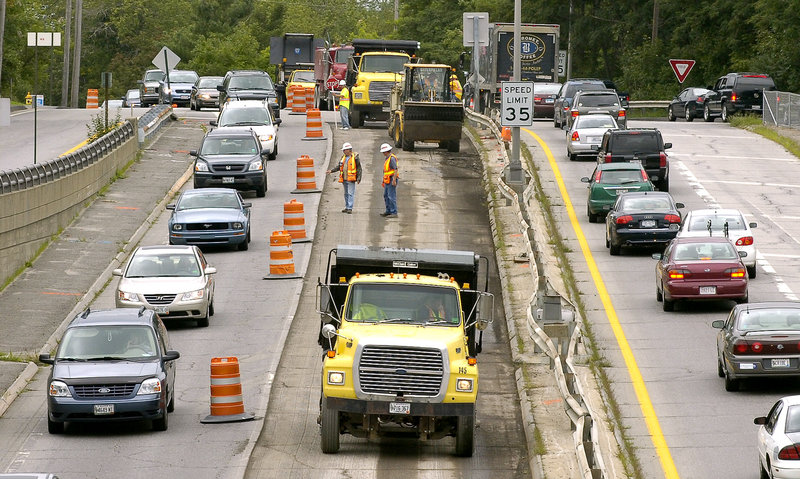PORTLAND – It could be us next time.
Superstorm Sandy wasn’t a direct hit to Maine, but areas of New Jersey and New York were devastated. This recent natural disaster is one reason that the new American Society of Civil Engineers’ 2012 update on Maine’s infrastructure is a call to action.
The best grade Maine earned was a B for airports; its worst grades are a D-plus for dams and municipal wastewater and a D for roads. The overall grade is a C-minus. We, along with our political leaders, need to make the commitment to improving our infrastructure.
The ASCE report is meant to raise public awareness regarding the importance of a modern and well-maintained infrastructure. As the report states, the “health, safety and welfare of our citizens are directly tied to the quality of our infrastructure. Current and forecasted funding is inadequate to meet current and future needs.”
Yet Maine’s overall C-minus grade is unchanged from 2008. The condition of Maine’s bridges and roads is dangerous to our families and friends, and the condition will only deteriorate.
The ASCE report offers numerous recommendations, including increased bonding, better prioritization and streamlined regulations. These measures could help our economy, increase jobs and decrease the everyday dangers we encounter. But hope isn’t a strategy.
We have a long way to go. The poorest grade that Maine received was a D for roads — no surprise to any vehicle owner.
According to ASCE, 38 percent of Maine’s major roads have either fair or unacceptable conditions, resulting in Maine motorists spending an average of $299 per year in additional vehicle operating costs. That’s about a week’s worth of take-home pay for the average Maine worker.
Maine has the largest number of highway miles in New England but the lowest amount of funding per mile. The Maine Department of Transportation has various legislative goals for roads and bridges, and to meet those goals, a funding gap of $150 a mile per year needs to be corrected.
Maine’s bridges received a C-minus. More than one in four of our 3,665 bridges are deficient — so there is a good chance you drive over a deficient bridge every day. More than half of our bridges were constructed more than 50 years ago, and 10 percent of the bridges are at least 80 years old.
Nearly one in three bridges is either structurally deficient or functionally beyond its useful life. This is not just a matter of infrastructure improvement, it’s a safety issue. Have we made some progress in four years? Yes. Did we make enough progress? Not even close.
Our state parks, central to our tourism economy, fell from a B-minus to a C-plus in the last four years. We are supposed to be “vacationland,” and “the way life should be,” but a C-plus is good for neither business nor tourism. Although our 48 state parks are graded as “adequate,” only minor improvements have been made in the past four years, resulting in the worsening grade.
The good news is that if we focus on making the necessary investments to our infrastructure, our economy will benefit, our construction industry will create more jobs and we will be a safer and healthier state.
The major bright spot in the report is our airports, which went from a B-minus to a B in the past four years. Maine’s airport system has taken on high-profile improvements, including a terminal building upgrade to Bangor’s International Airport and the recent $75 million upgrade at the Portland International Jetport.
More good news: While Maine isn’t going to have Dubai’s dazzling infrastructure or Japan’s bullet train, we have had some recent successes.
• In June, the new Veterans Bridge was opened between Portland and South Portland.
• Just a month ago, the Downeaster began daily passenger rail service to Freeport and Brunswick.
• The work on replacing the Memorial Bridge between Kittery and Portsmouth, N.H., is under way.
• The voters of the state passed a bond for improvements to drinking water and another for transportation.
Much of the funding since 2008 has been from the American Recovery and Reinvestment Act and resulted in Maine’s C-minus remaining a C-minus. That’s just not good enough.
We haven’t made progress in the past four years because we have failed to provide a significant enough investment in infrastructure to do anything more than tread water. A greater investment in our infrastructure will improve our state, create jobs and lower maintenance costs for the infrastructure.
Let’s not wait for our own superstorm. With the economy starting to improve and the jobless rates starting to go down, the time for investment is now.
Mike Bosse is an attorney and the Construction Law Practice Group Leader at Bernstein Shur in Portland.
Send questions/comments to the editors.



Success. Please wait for the page to reload. If the page does not reload within 5 seconds, please refresh the page.
Enter your email and password to access comments.
Hi, to comment on stories you must . This profile is in addition to your subscription and website login.
Already have a commenting profile? .
Invalid username/password.
Please check your email to confirm and complete your registration.
Only subscribers are eligible to post comments. Please subscribe or login first for digital access. Here’s why.
Use the form below to reset your password. When you've submitted your account email, we will send an email with a reset code.